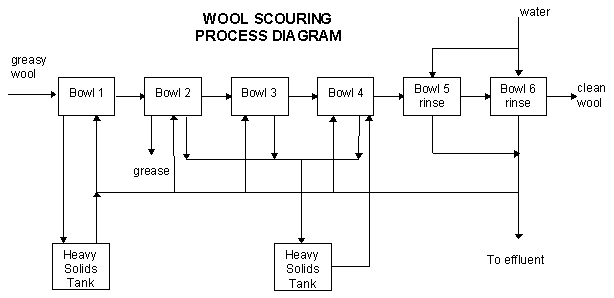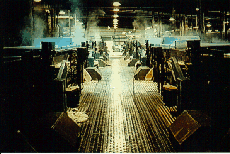Cleaner Production in Wool Scouring
ConAgra Wool Pty. Ltd.
| ConAgra Wool Pty. Ltd. has investigated a number of
cleaner production initiatives for their wool
scouring operation. The increased recovery of wool
grease and optimisation of sulphuric acid usage in
the carbonising process has provided significant
economic returns to the company. |
Contact
- Dr Richard White
- ConAgra Wool Pty. Ltd.
- 89-103 Doherty's Road
- Laverton North VIC 3026
- Ph: 61 3 9360 6100
- Fax: 61 3 9360 6170
Background
ConAgra Wool Pty. Ltd. is a wool scouring operation that
supplies scoured and carbonised wool to the global market.
The company participated in the Victorian Government's
Cleaner Production Demonstration Project in 1992.
The Process

The scouring process involves washing the wool in a
number of different "bowls" in open tanks which
contain various cleaning solutions - that together comprise a
scouring line. ConAgra has four scouring lines at its
Laverton plant. After passing through the scouring line, the
clean wool still contains some organic matter such as seed
burrs. These are removed by carbonising, a process involving
washing the wool with sulphuric acid, which dehydrates the
organic matter, then rinsing and drying in an oven. The
application of heat to the dehydrated organic matter turns it
into carbon, which can then be easily removed as a dust
material.
The scouring process generates significant quantities of
waste, including:
- 400 tonnes per annum (pa.) of sludge (disposal costs
in excess of $200,000 pa);
- 750 tonnes pa. of solid waste (disposal cost in
excess of $60,000 pa); and
- 750,000 cubic metres pa. of trade waste effluent,
with an annual discharge cost of $1.5 million. In
addition the cost of feed water is around $350,000
pa.
There are two main effluent streams at the plant:
- rinse streams, which have a relatively low
contaminant loading and can be discharged to the
sewer after minor treatment; and
- heavily contaminated effluent from the washing
stages, which does require treatment prior to
discharge to sewer.
In the existing process the overflows from the washing
bowls are sent to 'heavy solids' tanks, where the solids are
settled out and the wash solution is returned to the wash
bowls. The heavy solids tanks are located at some distance from
the scouring lines, and as the wash solutions operate at an
elevated temperature of 65 degrees Celsius, heat losses are
experienced. In addition, the heavy solids tanks are nearing
capacity as production volumes increase.
Current water usage is in the range of 20-25 litres per
kilogram of wool processed. The long term objective for
ConAgra is to halve this value.
Cleaner Production Initiatives
ConAgra participated in the Victorian Cleaner Production
Demonstration Program in 1992. The outcome from this program
was the identification of a number of potential cleaner
production processes that required further research and
development (R&D) work to establish their viability.
Participation in the program has led to an ongoing interest
in cleaner production. Initiatives have included:
- Installation of hydrocyclones on the wash baths of
one of the scouring lines to enhance solids removal,
and allow recycling of wash waters at each bowl. As
two of the scour lines process wool that is almost
identical, the installation of the hydrocyclones on
one of these lines allowed direct comparisons between
performance to be made. Energy costs were reduced
because of the need for only one pump, and heat loss
was reduced by not pumping to the remote heavy solids
tank. This project is still at the R&D stage.
- Combination of solid wastes from the scouring process
with solids from the grease plant to produce a
material that could be suitable as a compost or
compost additive. ConAgra is currently reviewing the
possibility of developing this as a commercial
operation.
- Improved grease recovery to achieve 35-40 per cent
reclaim of all grease in the wool. Two types of wool
grease are present in the wool - oxidised and
unoxidised. The split between the two is roughly
50/50, with the oxidised grease being of poorer
quality and harder to recover (because its specific
gravity is closer to that of water). Current
recoveries are 75-80 per cent for the unoxidised
grease and negligible for the oxidised grease. The
recovery efficiency has been enhanced by improved
monitoring practices and tighter maintenance on the
centrifuges. Formerly, grease recovery was running at
4 per cent of cleaned wool weight (incoming dirty
wool contains 10-15 per cent grease). This recovery
has increased to about 6 per cent of cleaned wool
weight.
- Optimisation of sulphuric acid in the carbonising
process. Tighter process monitoring identified
opportunities to reduce acid consumption by 25 per
cent.
- Optimising water usage and waste water generation.
This project has only recently commenced, with the
first stage aimed at quantifying effluent sources and
contaminant loadings at the unit process level.

The wool scour line
|
Advantages of the Process
The increased recovery of wool grease has had both
environmental and economic benefits. The increased grease
recovery has reduced the amount of Biochemical Oxygen Demand
and Suspended Solids in the final effluent discharge, with a
corresponding decrease in trade waste charges. Another
benefit from improved grease recovery has been an improvement
in washed wool quality. This has enabled ConAgra to maintain
its market share in the face of considerable competition.
ECONOMIC BENEFITS
|
| Costs |
$16,000 per line
|
| Annual
Savings |
$27,500 per line
|
| Payback
period |
0.6 years
|
Cleaner Production Incentive
The single most important incentive for ConAgra to
implement cleaner production initiatives has been the
potential cost reductions that can be achieved. ConAgra
already pays a significant amount of money for waste disposal
and discharge of effluent to the sewerage system, and there
is always attention being given to opportunities to reduce
these costs.
Barriers
Technical problems have been experienced with the
hydrocyclones. Excessive rates of internal wear from the high
solids loading has led to a search for more resistant
construction materials. The initial hydrocyclones were made
of a ceramic material, which has now been changed to a
polyurethane material. Problems have also been experienced
with solids buildup in the pumps, resulting in a decrease in
pumping efficiency.
The initial R&D work indicated that the hydrocyclones
worked effectively on the wash stages, and this was where the
initial work was targeted. When ConAgra expanded the fitting
of hydrocyclones to the rinse streams they found that they
were not as effective as had been expected. This resulted in
a level of disenchantment with the technology.
Accessing capital is also a barrier for ConAgra. This
means that capital expenditures, even where the pay back is
very attractive, need to placed into forward budget planning.
Case Study Prepared: January 1997 by ACCP

The Cleaner Production Case Studies Directory is part of EnviroNET Australia.
- For more information contact:
 Environment Australia
Environment Australia
Environment Protection Group
PO Box E305
KINGSTON ACT 2604
AUSTRALIA
Email: cproduction@ea.gov.au
URL: http://www.environment.gov.au/net/environet.html

